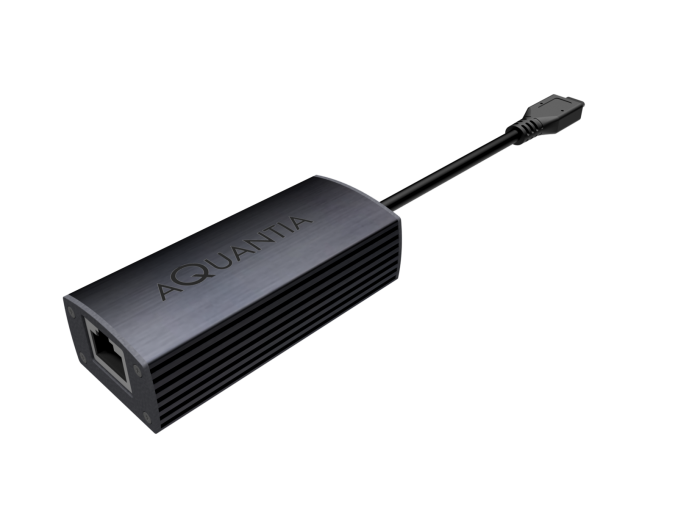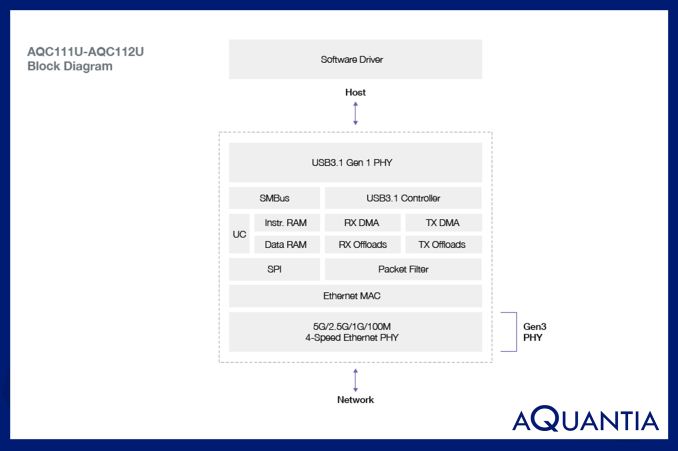Aquantia Multi-Gig: Single Chip USB 3.0 to 5G/2.5G Dongles Coming Soon
by Ian Cutress on June 4, 2018 9:05 AM EST
When discussing networking controllers, often we deal with single chips that convert PCIe to Ethernet. With Thunderbolt, an additional TB controller is needed at either end, increasing cost and power. However now with mobile devices losing dedicated Ethernet ports, and the rise in professional docking stations, converting from USB to a Wired Ethernet solution is usually a common choice for users that work out of hotels or those that want to add simple Ethernet capability to a device without any. Rather than use a USB-to-PCIe controller, Aquantia is pushing forward with its new generation of USB-to-Ethernet chips designed to run at 5G and 2.5G speeds.
The new chips, the AQtion AQC111U and the AQtion AQC112U, are designed to simply the USB-to-Ethernet scenario while supporting multi-gigabit Ethernet speeds. Dubbed as ‘the easiest way to implement multi-gig’, the new chips are set to be used in dongles and docking stations from the main ODMs and OEMs in this space: Bizlink, Edimax, Goodway, and Sunrich. Hardware will be available in Q4 2018.
For users looking to install point-to-point wired Ethernet speeds beyond 1 Gbps / 133 MBps, this looks like it is going to be the best option without a switch and without buying the bulky and power hungry TB3-to-10G adaptors that currently exist on the market.
Pricing will be announced by the vendors later this year, although to be commercially successful we hope that they will be in the $25-40 range. Equivalent 1G USB connectors currently cost sub-$10, for reference.
Related Reading
- AKiTiO’s Thunder3 10G Adapter Now Available: TB3-to-10GbE for Sub-$300
- Aquantia to Sell Its 5G and 10G Network Cards for $59 and $69 on Black Friday
- Aquantia Launch AQtion 5G/2.5G/1G Multi-Gigabit Ethernet Cards (NICs) for PCIe
- ASUS XG-U2008 10GBase-T Network Switch Released: 2x10G + 8x1G for $249
| Want to keep up to date with all of our Computex 2018 Coverage? | ||||||
 Laptops |
 Hardware |
 Chips |
||||
| Follow AnandTech's breaking news here! | ||||||
















13 Comments
View All Comments
PeachNCream - Monday, June 4, 2018 - link
It's nice to see faster ethernet becoming available over USB dongles, but I would prefer if we found a way to push wired network directly over USB natively as opposed to using a dedicated ethernet controller of some sort. I also see diminished uses for wired networking in non-enterprise environments like SOHO or residential installs. Certainly, there are people that need wired networks for various reasons, but it feels a lot like we're rapidly reaching a point where plugging into a network via RJ45 connectors is akin to finding a floppy diskette so you can save a file you're working on.johnthacker - Monday, June 4, 2018 - link
There already is a way to carry Ethernet over USB, but it's hard to see it having use cases apart from things like point to point connections for programming Arduino or Raspberry Pi system (https://software.intel.com/en-us/connecting-to-int... A dongle to convert it to a RJ45 connection makes more sense than having wall ports with a mix of USB and RJ45 (or optical in some offices), or switches with a mix of USB and RJ45. (I suppose you could try some kind of SFP based solution at the switch to support USB, but ugh.) Especially if you see diminished needs for wired networking, why would you propose wholesale rewiring rather than using a dongle to be compatible with existing wiring?I think that increasing residential density will keep wired networks quite useful simply due to interference on common channels for people who live in apartment buildings and other multifamily housing.
alevan - Monday, June 4, 2018 - link
You cannot use passive USB connection over 3 meters or active USB connection over 10 meters. Only the traditional ethernet/fiber is practical over large distances. But as you said, on portables users usualy use wireless connection, and wired if there is no alternative, with an USB adapter.PeachNCream - Monday, June 4, 2018 - link
I implied distance limitations would be overcome in the process of finding a way to put USB to use as a dongle-free network adapter. It's unrealistic to think that current USB standards would do the job, but some future iteration with appropriate cabling might be able to do so as an alternative to the largely wireless world in which we now reside for situations like the fully saturated WiFi spectrum problem John mentioned above.saratoga4 - Tuesday, June 5, 2018 - link
Electrically, something over a USB port can go a couple meters at gigabit speed, or a couple tens of meters much slower. The only way you overcome that limit is with a single that outputs something with with a lower symbol rate.saratoga4 - Tuesday, June 5, 2018 - link
Single -> dongleSamus - Monday, June 4, 2018 - link
USB voltage is too low for any realistic distance beyond 30 feet...oRAirwolf - Monday, June 4, 2018 - link
It sure would be nice if Aquantia would get their 10G base T switches out the door. These products are mostly worthless at this point without an accompanying reasonably priced switch. I have their 10Gbe NIC in my desktop with a direct connection to my NAS. It is nice but I have other servers that I would like to transition to 10 Gbe as well, but am still just waiting on the switch Aquantia showed off a while ago now.pixelstuff - Monday, September 10, 2018 - link
No need to jump all the way to 10G since that is apparently hard for vendors to pull off in a 16 / 24 port chassis. I'd be pretty satisfied if they would just start converting ALL of the 1G switch to 2.5G switches with a couple 5G or 10G uplink ports.pixelstuff - Monday, September 10, 2018 - link
Just noticed D-Link might be taking the first steps with the new DMS-1100-10TS and DMS-1100-10TP 8-port 2.5 Gbps switches with a 10 Gb uplink.